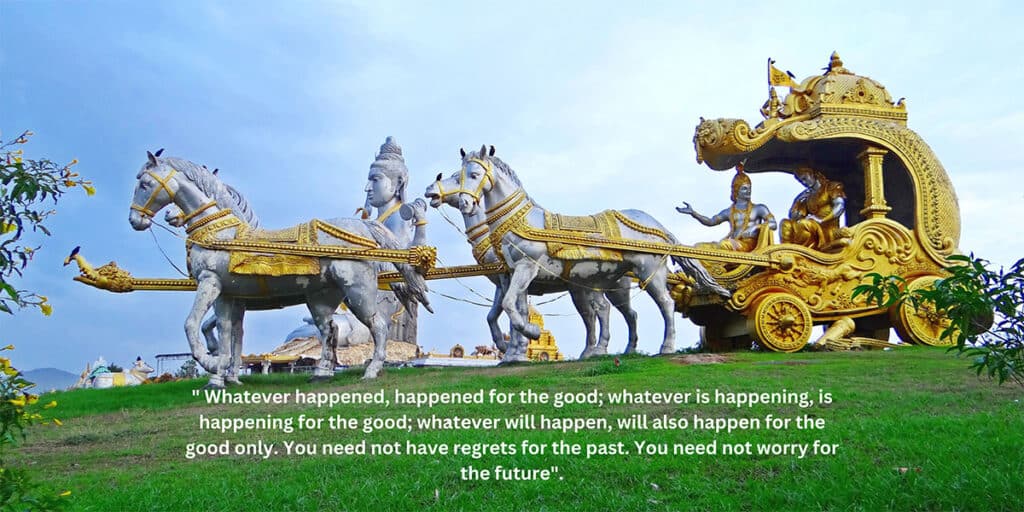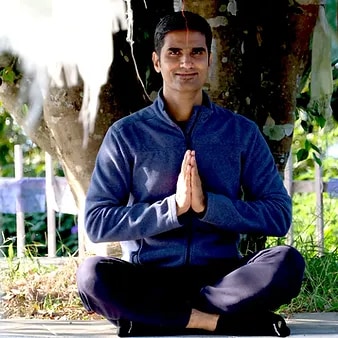Lessons from the Bhagavad Gita by Lord Krishna
by Hardik Mehta

The Bhagavad Gita, a sacred text of immense spiritual significance, has been revered for centuries as a guide to living a life of purpose, wisdom, and peace. Delivered by Lord Krishna to the warrior prince Arjuna on the battlefield of Kurukshetra, the teachings of the Gita transcend religious boundaries and offer timeless wisdom applicable to all aspects of life.
In this blog, we will explore some of the profound lessons from the Bhagavad Gita, delving into its core messages and how they can be applied in our modern lives to achieve inner peace, self-realization, and fulfilment.
1. The Essence of Dharma (Duty)
One of the central teachings of the Bhagavad Gita is the concept of Dharma, which refers to one’s duty or righteous path. Lord Krishna emphasizes that every individual has a specific role to play in life, and fulfilling that role with sincerity and dedication is crucial to achieving spiritual growth.
In the context of the Gita, Arjuna’s Dharma as a warrior was to fight in the battle, even though it meant going against his own kin. Krishna advises Arjuna that performing his duty without attachment to the results is the highest form of righteousness. This lesson teaches us the importance of understanding our responsibilities and fulfilling them with unwavering commitment, without being swayed by personal desires or fears.
In our contemporary world, this principle can be applied to our careers, relationships, and personal growth. By focusing on our duties with integrity and without attachment to outcomes, we can maintain balance and harmony in our lives.
2. The Power of Detachment
Another profound lesson from the Bhagavad Gita is the importance of detachment. Krishna teaches Arjuna the concept of “Nishkama Karma,” which emphasizes carrying out one’s duties without any attachment to the outcome or desire for personal gain. This principle is a cornerstone of the Gita’s philosophy and encourages individuals to act selflessly, without being driven by ego or desire.
Detachment does not mean renouncing life or responsibilities; rather, it is about cultivating an inner state of equanimity where one is not affected by success or failure. This mindset helps in reducing stress, anxiety, and emotional turmoil, allowing us to navigate life’s challenges with grace and composure.
In the modern context, practicing detachment can lead to greater mental clarity and emotional resilience. Whether in our professional endeavours or personal relationships, letting go of the need for validation or material gains can liberate us from the cycle of suffering and lead to true contentment.
3. Self-Realization and the Path to Moksha
The Bhagavad Gita profoundly explores the essence of the self and the highest aim of human life, which is attaining self-realization or liberation, known as Moksha. According to Krishna, the true self (Atman) is eternal and beyond the physical body. Realizing this truth is the key to liberation from the cycle of birth and death (Samsara).
Krishna explains that the path to self-realization involves practicing meditation, self-discipline, and devotion. By transcending the limitations of the ego and recognizing our oneness with the divine, we can attain a state of eternal bliss and freedom.
For those seeking spiritual growth, the Gita’s teachings on self-realization provide a roadmap for inner transformation. When we synchronize our thoughts, actions, and intentions with the divine, we can achieve a deep sense of peace and fulfilment.
4. The Importance of Surrender and Faith
Surrendering to a higher power and having faith in the divine plan is another key teaching of the Bhagavad Gita. Krishna advises Arjuna to surrender his will to God and trust in the divine wisdom. This act of surrender is not a sign of weakness but rather a recognition of the limitations of the human mind and the infinite wisdom of the divine.
Surrendering to the divine allows us to let go of control and accept life’s unfolding with grace. It teaches us to have faith in the process and trust that everything happens for a reason, even if it is not immediately apparent.
In today’s fast-paced world, where uncertainty and change are constant, cultivating a sense of surrender and faith can help us navigate life’s ups and downs with a sense of calm and assurance. It reminds us that we are not alone in our journey and that there is a higher power guiding us toward our ultimate purpose.
5. The Role of Yoga in Achieving Balance
The Bhagavad Gita introduces various forms of yoga as paths to spiritual growth and self-realization. These include Karma Yoga (the yoga of action), Bhakti Yoga (the yoga of devotion), Jnana Yoga (the yoga of knowledge), and Dhyana Yoga (the yoga of meditation).
Krishna emphasizes that yoga is not just a physical practice but a holistic approach to life that integrates the body, mind, and spirit. By practicing yoga in its various forms, one can achieve balance, harmony, and a deeper connection with the divine.
For those who are new to yoga or wish to deepen their practice, the Gita’s teachings offer valuable insights into the transformative power of yoga. Whether through selfless service, devotion, or meditation, yoga provides a path to inner peace and spiritual growth.
6. The Transience of Life and the Eternal Soul
The Bhagavad Gita reminds us of the impermanence of life and the eternal nature of the soul. Krishna explains to Arjuna that the body is temporary and subject to decay, but the soul is eternal and indestructible. This understanding helps to alleviate the fear of death and encourages a focus on the spiritual journey.
By recognizing the transience of material life, we can shift our focus from worldly pursuits to spiritual growth. The Gita teaches us to live with awareness, mindfulness, and a sense of detachment from the physical world, knowing that our true essence is beyond the material realm.
The Timeless Wisdom of the Bhagavad Gita
The Bhagavad Gita’s teachings are as relevant today as they were thousands of years ago. In a world filled with challenges, uncertainties, and distractions, the Gita offers timeless wisdom that can guide us toward a life of purpose, peace, and fulfilment. Whether through the practice of Dharma, the cultivation of detachment, or the pursuit of self-realization, the lessons of the Gita provide a roadmap for living a life aligned with divine principles.
At Sayujya Yoga, we believe in integrating these ancient teachings with contemporary practices to help individuals achieve holistic well-being. As one of the best yoga institutes in Mumbai, we offer a comprehensive 200 Hours Teacher Training Course (TTC) and a variety of short courses designed to deepen your understanding of yoga and its profound philosophies. Our courses are rooted in the rich tradition of yoga, blended with modern techniques, to create a transformative experience for our students. Whether you are a beginner or an experienced practitioner, Sayujya Yoga provides a supportive environment to explore the depths of your practice and embark on a journey of self-discovery.
Join us at Sayujya Yoga and experience the profound benefits of yoga, guided by the timeless wisdom of the Bhagavad Gita. Let us help you find balance, peace, and inner strength as you connect with your true self and the divine.
About the Author

Hardik Mehta
Hardik is an E-RYT 500 & YACEP (Yoga Alliance Continuing Education Provider), Yoga Alliance, USA. He has been practicing yoga for the last 9 years. Prior to finding his true calling in Yoga, he was working with various corporates for 12 years in the Retail and eCommerce sector.
